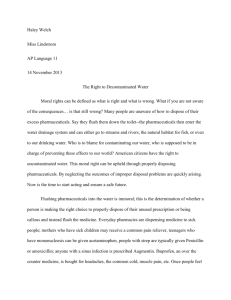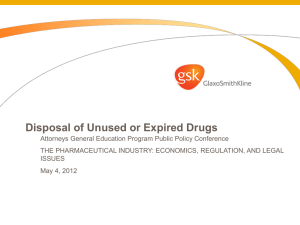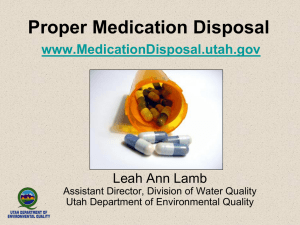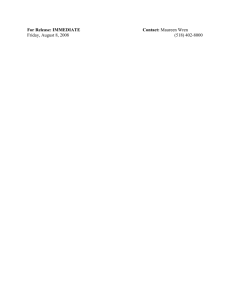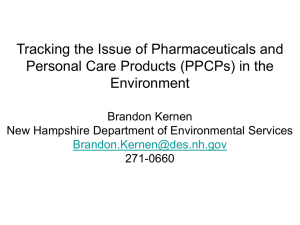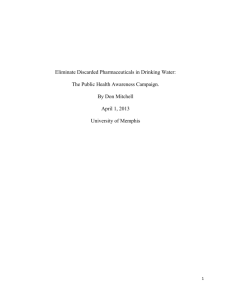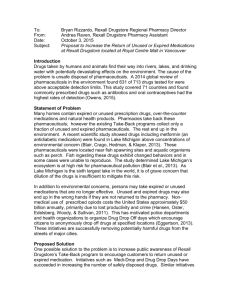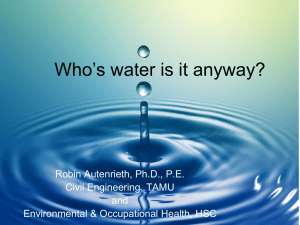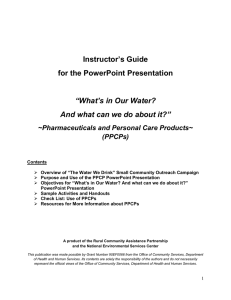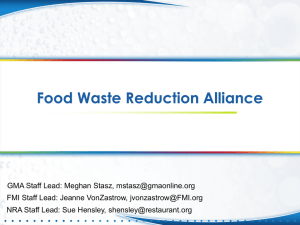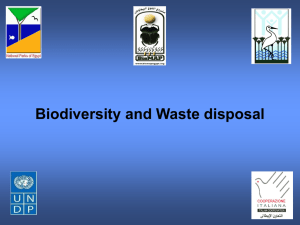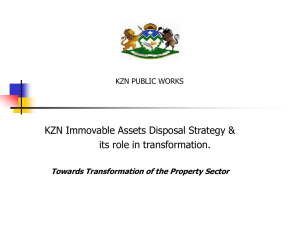proper-medication-disposal-program-by-susanna-littell
advertisement
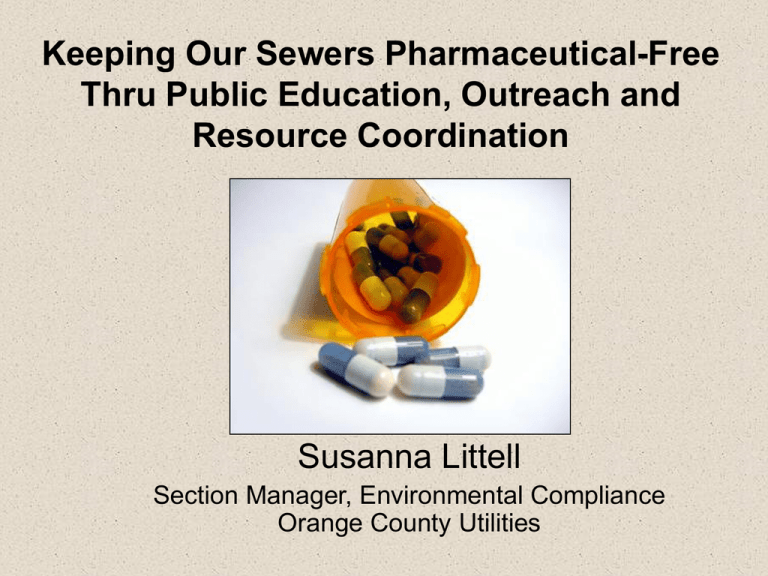
Keeping Our Sewers Pharmaceutical-Free Thru Public Education, Outreach and Resource Coordination Susanna Littell Section Manager, Environmental Compliance Orange County Utilities Overview • Pharmaceuticals and Personal Care Products (PPCPs) are classified as Emerging Substances of Concern • Are discharged to sewers by many sources • Environmental impacts • Limited and restrictive regulations to control discharges • Promote education and BMPs to address Pharmaceuticals and Personal Care Products as Pollutants PPCPs include over 14 million chemical compounds: • Prescription and over-the counter drugs • Veterinary drugs • Fragrances • Cosmetics • Sun-screen products • Diagnostic agents • Nutraceuticals (e.g., vitamins) General PPCP Usage PPCPs are used by: • Individuals for personal health or cosmetic reasons • Agribusiness to enhance growth or health of livestock. PPCP Source Pathways to the Sewer • Ingested then excreted • Discharged during bathing • Discharged during medication disposal • 50% of all unused prescriptions • 80% of all unused antibiotics PPCP Sources •Manufacturing process waste •Wastes from the distributor, pharmacy, hospital and healthcare facility •Wastes from residential care facilities •Pharmaceuticals from the consumer •Excreted metabolites entering wastewater PPCP Environmental Pathways •Pass through septic tanks to aquifer •Pass through WWTPs and enter: –Aquifers –Surface waters –Reclaimed water areas –Biosolid application areas PPCP Discharge Standards • 14 Drinking-water standards (DWS) or other human or ecological health criteria have been established •Only 1% (250,000) of 14 million chemicals have regulatory controls •POTWs will eventually have discharge limits •CIU category for PPCPs proposed Pharmaceutical Controls •RCRA for the disposal of hazardous pharmaceutical wastes produced by pharmaceutical manufacturers and the health care industry •Controlled Substance Act – Criteria includes DEA registration to handle controlled substances in schedules II through V Controlled Substances http://www.deadiversion.usdoj.gov/schedules/schedules.htm • Schedule I – illegal drugs (ex., heroin, LSD) • Schedule II – Morphine, OxyContin, codeine, Demerol, Ritalin, amphetamines • Schedule III – Tylenol with codeine, Vicodin • Schedule IV – Benzodiazepines, Valium, Darvon • Schedule V – Codeine cough syrups Unused Pharmaceuticals Too Many Pharmaceuticals Go Unused… • PhRMA uses an estimate of 3% of all meds go unused: – 82% of antibiotics go unused – 50% of antidepressants – 50% of beta-blockers – 20% of pain meds • Waste management compliance rates for some medications are < 20% • Medicare Part D and others require 30-day supply billings, regardless of need and without ability to refund unused expenses (or to return unused product) Ensure Proper Waste Disposal • Modify SUO to address this discharge • Inspect commercial and industrial facilities to ensure proper waste disposal: – Wastes are returned to manufacturer – RCRA waste are properly disposed of directly – Wastes are manage through a ‘Reverse Distributor” • Recycled or incinerated, depending on waste type, packaging • 6 Reverse Distributors in Florida • DEA Website: http://www.deadiversion.usdoj.gov Educate Consumers of Proper Waste Disposal First… •Develop educational info for customer distribution: –Direct mailing, utility bill stuffers –TV Commercial, radio spots –Direct education (community events Earth Day events, HOAs, senior community centers,…) •Consider using FDEP & AWWA educational materials Provide Consumers Pharmaceutical Waste Disposal Options Second… •Contact the local police department to see if they have a drug collection program •Create your own drug collection program (with required police participation) –Partner local police directly –Partner with police during Household Hazardous Waste events –Advertise these events! Provide Consumers Pharmaceutical Waste Disposal Options Lastly, if no collection options exist, or will be provided, consider recommending consumers to: • Remove all personal identification from prescription bottles; • Mix all unused drugs with coffee grounds, kitty litter, or another undesirable substance, and/or • Place this mixture in a sealed container before disposing in the trash, on the day of pick-up. Provide Consumers Pharmaceutical Waste Disposal Program Funding Grants are available to Law Enforcement Agencies to Establish a “Drug Collection for Proper Disposal” Program • The Federal Government offers law enforcement agencies a one-time grant, up to $1,000, to establish a “Drug Collection for Proper Disposal” program. This funding can be used to pay for: collection boxes, signage, evidence handling, incineration, advertising or associated expenses. Sources of Information Contained in this Presentation References: Pharmaceuticals and Personal Care Products as Pollutants (PPCPs), EPA Web Site: http://www.epa.gov/ppcp/
